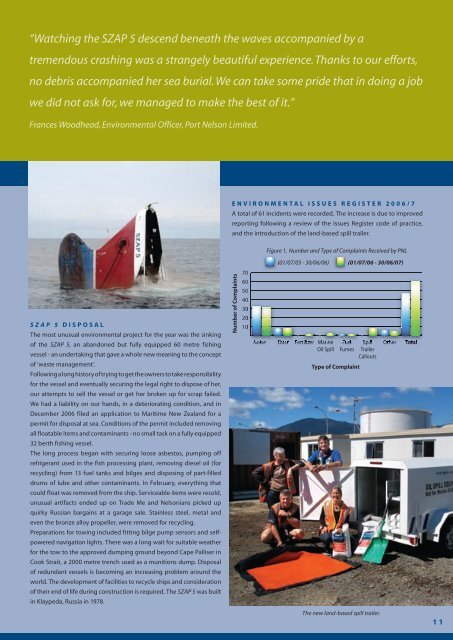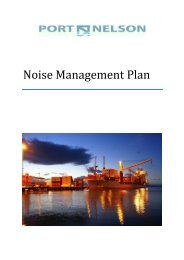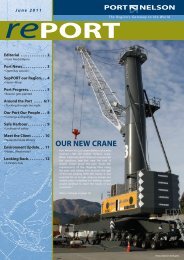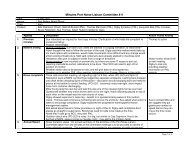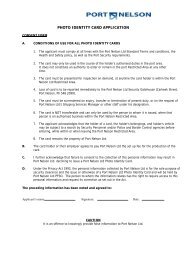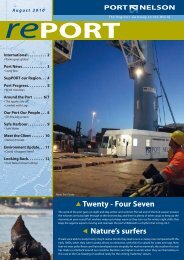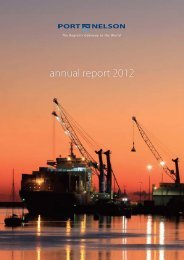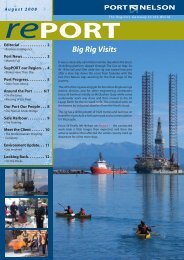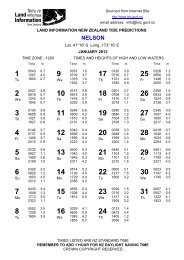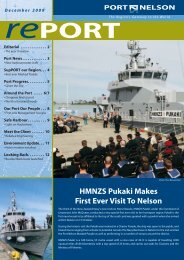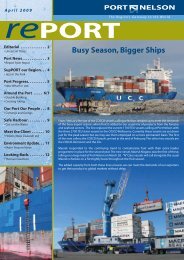Port Nelson Annual Report 2007 (pdf)
Port Nelson Annual Report 2007 (pdf)
Port Nelson Annual Report 2007 (pdf)
Create successful ePaper yourself
Turn your PDF publications into a flip-book with our unique Google optimized e-Paper software.
“Watching the SZAP 5 descend beneath the waves accompanied by a<br />
tremendous crashing was a strangely beautiful experience. Thanks to our efforts,<br />
no debris accompanied her sea burial. We can take some pride that in doing a job<br />
we did not ask for, we managed to make the best of it.”<br />
Frances Woodhead, Environmental Officer, <strong>Port</strong> <strong>Nelson</strong> Limited.<br />
E N V I R O N M E N T A L I S S U E S R E G I S T E R 2 0 0 6 / 7<br />
A total of 61 incidents were recorded. The increase is due to improved<br />
reporting following a review of the Issues Register code of practice,<br />
and the introduction of the land-based spill trailer.<br />
S Z A P 5 D I S P O S A L<br />
The most unusual environmental project for the year was the sinking<br />
of the SZAP 5, an abandoned but fully equipped 60 metre fishing<br />
vessel - an undertaking that gave a whole new meaning to the concept<br />
of ‘waste management’.<br />
Following a long history of trying to get the owners to take responsibility<br />
for the vessel and eventually securing the legal right to dispose of her,<br />
our attempts to sell the vessel or get her broken up for scrap failed.<br />
We had a liability on our hands, in a deteriorating condition, and in<br />
December 2006 filed an application to Maritime New Zealand for a<br />
permit for disposal at sea. Conditions of the permit included removing<br />
all floatable items and contaminants - no small task on a fully equipped<br />
32 berth fishing vessel.<br />
The long process began with securing loose asbestos, pumping off<br />
refrigerant used in the fish processing plant, removing diesel oil (for<br />
recycling) from 13 fuel tanks and bilges and disposing of part-filled<br />
drums of lube and other contaminants. In February, everything that<br />
could float was removed from the ship. Serviceable items were resold,<br />
unusual artifacts ended up on Trade Me and <strong>Nelson</strong>ians picked up<br />
quirky Russian bargains at a garage sale. Stainless steel, metal and<br />
even the bronze alloy propeller, were removed for recycling.<br />
Preparations for towing included fitting bilge pump sensors and selfpowered<br />
navigation lights. There was a long wait for suitable weather<br />
for the tow to the approved dumping ground beyond Cape Palliser in<br />
Cook Strait, a 2000 metre trench used as a munitions dump. Disposal<br />
of redundant vessels is becoming an increasing problem around the<br />
world. The development of facilities to recycle ships and consideration<br />
of their end of life during construction is required. The SZAP 5 was built<br />
in Klaypeda, Russia in 1978.<br />
The new land-based spill trailer.<br />
1 1


